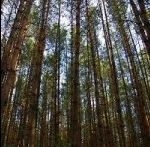You Can Love Wood And Still Be A Forest Hugger
Posted: January 16, 2017Source: Huffington Post

IMAGE BY POLINA RYAZANTSEVA /DREAMSTIME.COM
You have probably bought forest products like lumber for a home reno or notepaper for school supplies and wondered how your purchase affects the forest it came from. You may feel guilty, but you shouldn’t if the forest products you buy are harvested sustainably and certified to internationally recognized standards. In fact, you should feel proud.
You’re actually a fully qualified forest hugger if you buy forest products from well-managed forests that provide conservation benefits like clean air and water, habitats for a variety of species and recreational opportunities.
Sustainably harvested forest products protect forests
Sustainable harvesting from well-managed forests is the opposite of deforestation. Deforestation changes the landscape by turning a forest into something else like a parking lot or a strip mall. It gets rid of all of the benefits of forests, including the habitats they provide for wildlife, the recreational value they have for everyone, and the very real forest superpower of carbon sequestration, which helps fight climate change. Nobody is disputing the message that deforestation is to be avoided.
“Responsible forestry ensures that forests can continue to provide social, economic, and environmental benefits today and in the future.”
However, in spreading the message of the dangers of deforestation, all forest products — including sustainably sourced ones — can get painted with the same brush. This blurred line is problematic since a sustainably harvested forest provides all the paper and wood products we need without the negative effects of deforestation. Well-managed forests also include the positive benefits of supporting rural economies with meaningful jobs and providing us with products that improve our lives. Supporting well-managed forests means they will continue to be perceived as having value, which means they are more likely to remain as forests and not suffer from deforestation.
It’s also important to remember that the rate of deforestation in Canada is virtually zero because all trees that are harvested must be replanted. In fact, every year many more trees are lost to fire and disease than harvesting.
Sustainable forest management 101
Responsible forestry ensures that forests can continue to provide social, economic, and environmental benefits today and in the future. There are various organizations that have developed forest certification standards to help you purchase products from responsibly managed forests. But today, only 10 per cent of our forests worldwide are certified to these forestry standards, a number that needs to increase. We need parks and other protected areas, along with widespread sustainable forestry, to ensure the conservation and restoration of the world’s forests.
Finding suitable forest products: Look for certification labels, not words green, natural and forest-friendly are words and phrases that you may hear used in the marketing of forest products. But in the absence of proof of a proper third-party certification standard, they are meaningless. The three forest certification standards to look for in North America are:
– Sustainable Forestry Initiative (SFI)
– Forest Stewardship Council (FSC)
– Canadian Standards Association (CSA) Sustainable Forest Management Standard
Why look for products that carry certification labels? They all rely on independent third parties to certify forests to their standards. These three standards involve a number of extensive qualifications, including a solid chain of custody to ensure that products are coming from a responsibly managed forest, best practices for sustainable forest management, and procurement requirements.
Be a forest hugger by supporting forest certification
Forests certified to SFI cover the equivalent of about 100 million soccer fields, stretching from Canada’s boreal forest to the U.S. South. These working forests provide so many benefits, they provide a place to camp, hike, and fish. They provide clean air and water and habitat for common and rare species. The forest products made from these certified forests also provide livelihoods for many Canadians.
So be a forest hugger — cozy up with a book or magazine, buy your eggs in a paper carton, and don’t feel guilty. Just look for certification labels before you buy your paper and forest products to make sure you are purchasing products from a responsibly managed forest.
